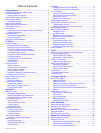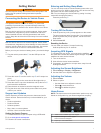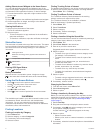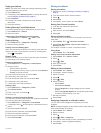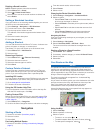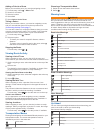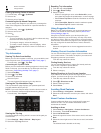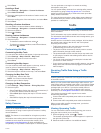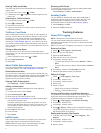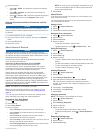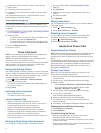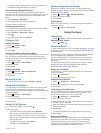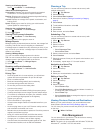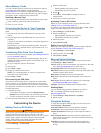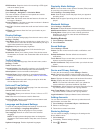
6
Select
Done.
Avoiding a Road
1
Select Settings > Navigation
> Custom Avoidances
.
2
Select
Add Avoid Road.
3
Select the starting point of the section of road to avoid, and
select Next
.
4
Select the ending point of the road section, and select Next.
5
Select
Done.
Disabling a Custom Avoidance
You can disable a custom avoidance without deleting it.
1
Select Settings
> Navigation > Custom Avoidances
.
2
Select an avoidance.
3
Select >
Disable
.
Deleting Custom Avoidances
1
Select Settings
> Navigation > Custom Avoidances
.
2
Select an option:
• To delete all custom avoidances, select .
• To delete one custom avoidance, select the avoidance,
and select >
Delete
.
Customizing the Map
Customizing the Map Tools
You can select the shortcuts that appear in the map tools menu.
1
Select Settings >
Map & Vehicle > Map Tools
.
2
Select the map tools to include in the menu.
3
Select
Save.
Customizing the Map Layers
You can customize which data appear on the map, such as
icons for points of interest and road conditions.
1
Select Settings > Map & Vehicle >
Map Layers
.
2
Select the layers to include on the map, and select Save
.
Changing the Map Data Field
1
From the map, select a data field.
NOTE: You cannot customize Speed.
2
Select a type of data to display.
Changing the Map Perspective
1
Select Settings
> Map & Vehicle > Driving Map View
.
2
Select an option:
• Select
Track Up to display the map in two dimensions (2-
D), with your direction of travel at the top.
• Select
North Up to display the map in 2-D with north at
the top.
• Select
3-D to display the map in three dimensions.
3
Select
Save.
Safety Cameras
NOTICE
Garmin is not responsible for the accuracy of or the
consequences of using a custom point of interest or a safety
camera database.
NOTE: This feature is not available for all regions or product
models.
Information about safety camera locations and speed limits is
available in some areas for some product models. Go to
www.garmin.com/safetycameras
to check availability and
compatibility, or to purchase a subscription or one-time update.
You can purchase a new region or extend an existing
subscription at any time.
You can update safety cameras for an existing safety camera
subscription by going to
http://my.garmin.com. You should
update your device frequently to receive the most up-to-date
safety camera information.
For some devices and regions, basic safety camera data may
be included with your device. Included data does not include
updates or a subscription.
Traffic
NOTICE
Garmin is not responsible for the accuracy or timeliness of the
traffic information.
Traffic information may not be available in all areas or countries.
For information about traffic receivers and coverage areas, go to
www.garmin.com/traffic.
A traffic receiver is included in some packages, built into either
the vehicle power cable or the device, and is an optional
accessory for all models.
• Traffic alerts appear on the map when there are traffic
incidents along your route or in your area.
• The device must be connected to vehicle power to receive
traffic information through a traffic receiver.
• The powered traffic receiver and the device may need to be
in data range of a station transmitting traffic data to receive
traffic information.
• You do not need to activate the subscription included with
your device or traffic receiver.
• If your device includes an external traffic antenna, you should
always leave the external antenna plugged in for the best
traffic reception.
Receiving Traffic Data Using a Traffic
Receiver
NOTICE
Heated (metallized) windshields could degrade the performance
of the traffic receiver.
Before you can receive traffic data using a traffic receiver, you
must have a traffic-compatible power cable. If your device model
includes lifetime traffic, you should use the vehicle power cable
packaged with your device. If your device model does not
include traffic, you must purchase a Garmin
traffic receiver
accessory. Go to
www.garmin.com/traffic for more information.
Your device can receive traffic signals from a station
broadcasting traffic data.
1
Connect the traffic-compatible power cable to an external
power source.
2
Connect the traffic-compatible power cable to the device.
When you are within a traffic coverage area, your device
displays traffic information.
Viewing Upcoming Traffic
You can view traffic incidents coming up along your route or
along the road on which you are traveling.
1
While navigating a route, select > Traffic.
The nearest upcoming traffic incident appears in a panel on
the right side of the map.
2
Select the traffic incident to view additional details.
Traffic 7



